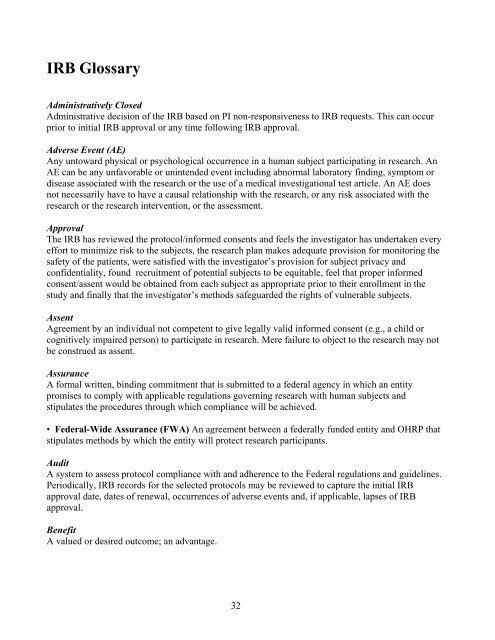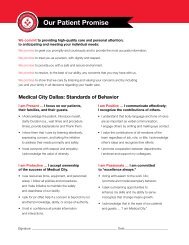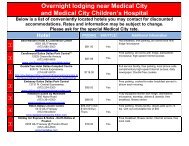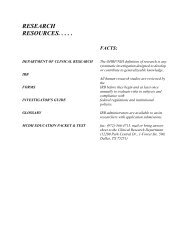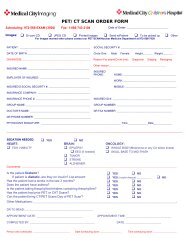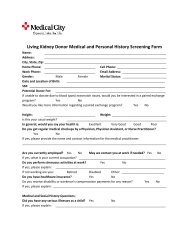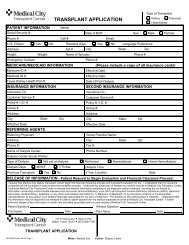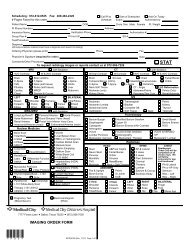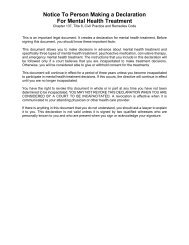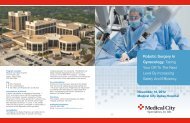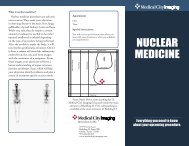MCDH Protection from Research Risk Program - Medical City Dallas ...
MCDH Protection from Research Risk Program - Medical City Dallas ...
MCDH Protection from Research Risk Program - Medical City Dallas ...
Create successful ePaper yourself
Turn your PDF publications into a flip-book with our unique Google optimized e-Paper software.
IRB Glossary<br />
Administratively Closed<br />
Administrative decision of the IRB based on PI non-responsiveness to IRB requests. This can occur<br />
prior to initial IRB approval or any time following IRB approval.<br />
Adverse Event (AE)<br />
Any untoward physical or psychological occurrence in a human subject participating in research. An<br />
AE can be any unfavorable or unintended event including abnormal laboratory finding, symptom or<br />
disease associated with the research or the use of a medical investigational test article. An AE does<br />
not necessarily have to have a causal relationship with the research, or any risk associated with the<br />
research or the research intervention, or the assessment.<br />
Approval<br />
The IRB has reviewed the protocol/informed consents and feels the investigator has undertaken every<br />
effort to minimize risk to the subjects, the research plan makes adequate provision for monitoring the<br />
safety of the patients, were satisfied with the investigator’s provision for subject privacy and<br />
confidentiality, found recruitment of potential subjects to be equitable, feel that proper informed<br />
consent/assent would be obtained <strong>from</strong> each subject as appropriate prior to their enrollment in the<br />
study and finally that the investigator’s methods safeguarded the rights of vulnerable subjects.<br />
Assent<br />
Agreement by an individual not competent to give legally valid informed consent (e.g., a child or<br />
cognitively impaired person) to participate in research. Mere failure to object to the research may not<br />
be construed as assent.<br />
Assurance<br />
A formal written, binding commitment that is submitted to a federal agency in which an entity<br />
promises to comply with applicable regulations governing research with human subjects and<br />
stipulates the procedures through which compliance will be achieved.<br />
• Federal-Wide Assurance (FWA) An agreement between a federally funded entity and OHRP that<br />
stipulates methods by which the entity will protect research participants.<br />
Audit<br />
A system to assess protocol compliance with and adherence to the Federal regulations and guidelines.<br />
Periodically, IRB records for the selected protocols may be reviewed to capture the initial IRB<br />
approval date, dates of renewal, occurrences of adverse events and, if applicable, lapses of IRB<br />
approval.<br />
Benefit<br />
A valued or desired outcome; an advantage.<br />
32
Beneficence<br />
An ethical principle discussed in the Belmont Report that entails an obligation to protect persons<br />
<strong>from</strong> harm. The principle of beneficence can be expressed in two general rules: (1) do not harm; and<br />
(2) protect <strong>from</strong> harm by maximizing possible benefits and minimizing possible risks of harm.<br />
Case Report Form (CRF)<br />
A printed, optical, or electronic document designed to record all of the protocol-required information<br />
to be reported to the sponsor on each trial subject.<br />
Children<br />
Persons who have not attained the legal age for consent to treatment or procedures involved in the<br />
research, as determined under the applicable law of the jurisdiction in which the research will be<br />
conducted. A formal assent is required before children participate in research.<br />
Clinical Trial<br />
A controlled study involving human subjects, designed to evaluate prospectively the safety and<br />
effectiveness of new drugs or devices or of behavioral interventions.<br />
Cognitively Impaired<br />
Having either a psychiatric disorder (e.g., psychosis, neurosis, personality or behavior disorders, or<br />
dementia) or a developmental disorder (e.g., mental retardation) that affects cognitive or emotional<br />
functions to the extent that capacity for judgment and reasoning is significantly diminished. Others,<br />
including persons under the influence of or dependent on drugs or alcohol, those suffering <strong>from</strong><br />
degenerative diseases affecting the brain, terminally ill patients, and persons with severely disabling<br />
physical handicaps, may also be compromised in their ability to make decisions in their best interests.<br />
Competence<br />
Technically, a legal term, used to denote capacity to act on one's own behalf; the ability to understand<br />
information presented, to appreciate the consequences of acting (or not acting) on that information,<br />
and to make a choice.<br />
Compliance<br />
Adherence to all the trial-related requirements, good clinical practice (GCP) requirements, and the<br />
applicable regulatory and institutional requirements.<br />
Confidentiality<br />
Pertains to the treatment of information that an individual has disclosed in a relationship of trust and<br />
with the expectation that it will not be divulged to others without permission in ways that are<br />
inconsistent with the understanding of the original disclosure.<br />
Continuing Review<br />
Periodic review of a research study by an IRB to evaluate whether risks to participants are reasonable<br />
in relation to potential benefits and to verify that the study continues to meet regulatory and<br />
institutional requirements. Continuing review shall be conducted at intervals appropriate to the<br />
degree of risk but not less than once per year.<br />
33
Data and Safety Monitoring Board<br />
A committee of scientists, physicians, statisticians, and others that collects and analyzes data during<br />
the course of a clinical trial to monitor for adverse effects and other trends (such as an indication that<br />
one treatment is significantly better than another, particularly when one arm of the trial involves a<br />
placebo control) that would warrant modification or termination of the trial or notification of subjects<br />
about new information that might affect their willingness to continue in the trial.<br />
Deviation<br />
Any change, divergence, or departure <strong>from</strong> the study design or procedures of a research protocol that<br />
is under the investigator’s control & that has not been approved by the IRB.<br />
Drug<br />
Any chemical compound that may be used on or administered to humans as an aid in the diagnosis,<br />
treatment, cure, mitigation, or prevention of disease or other abnormal conditions.<br />
Entity<br />
An organization, institution or being that has its own existence for legal or tax purposes and possess<br />
OHRP-approved Assurances.<br />
Exempt <strong>Research</strong><br />
<strong>Research</strong> determined by the Institutional Review Board (IRB) to involve human subjects only in<br />
activities involving minimal risk (i.e. surveys, data collection, retrospective chart review).<br />
Expedited Review<br />
Review of proposed research by the IRB chair or a designated voting member rather than by the<br />
entire IRB. Federal rules permit expedited review for certain kinds of research involving no more<br />
than minimal risk and for minor changes in approved research (i.e. Exempt Studies).<br />
Experimental<br />
Term often used to denote a therapy (drug, device, procedure) that is unproven or not yet<br />
scientifically validated with respect to safety and efficacy. A procedure may be considered<br />
"experimental" without necessarily being part of a formal study (research) to evaluate its usefulness.<br />
FDA<br />
Food and Drug Administration; an agency of the federal government established by Congress in 1912<br />
and presently part of the Department of Health and Human Services.<br />
Full Board Review<br />
Review of proposed research at a convened meeting at which a majority of the voting membership of<br />
the IRB is present, including at least one member whose primary concerns are in nonscientific areas.<br />
For the research to be approved, it must receive the approval of a majority of those voting members<br />
present at the meeting.<br />
Grant<br />
Financial support provided for research study designed and proposed by the Principal Investigator(s).<br />
34
The granting agency exercises no direct control over the conduct of approved research supported by a<br />
grant.<br />
Guardian<br />
An individual who is authorized under applicable state or local law to give permission on behalf of a<br />
child to general medical care.<br />
HIPAA<br />
Health Insurance Portability and Accountability Act of 1996. This mandates the maintenance of<br />
privacy for a subjects’ personal information.<br />
Human Subjects<br />
Individuals whose physiologic or behavioral characteristics and responses are the object of study in a<br />
research project. Under the federal regulations, human subjects are defined as: living individual(s)<br />
about whom an investigator conducting research obtains; (1) data through intervention or interaction<br />
with the individual; or (2) identifiable private information.<br />
Incapacity<br />
Refers to a person's mental status and means inability to understand information presented, to<br />
appreciate the consequences of acting (or not acting) on that information, and to make a choice. Often<br />
used as a synonym for incompetence. See also<br />
Incompetence<br />
Technically, a legal term meaning inability to manage one's own affairs.<br />
Often used as a synonym for incapacity.<br />
Informed Consent<br />
A person's voluntary agreement, based upon adequate knowledge and understanding of relevant<br />
information, to participate in research or to undergo a diagnostic, therapeutic, or preventive<br />
procedure. In giving informed consent, subjects may not waive or appear to waive any of their legal<br />
rights, or release or appear to release the investigator, the sponsor, the entity or agents thereof <strong>from</strong><br />
liability for negligence.<br />
Institutional Review Board (IRB)<br />
A specially constituted review body established or designated by an entity to protect the welfare of<br />
human subjects recruited to participate in biomedical or behavioral research.<br />
Investigational Device Exemptions (IDE)<br />
Exemptions <strong>from</strong> certain regulations found in the <strong>Medical</strong> Device Amendments that allow shipment<br />
of unapproved devices for use in clinical investigations.<br />
Investigational New Drug or Device<br />
A drug or device permitted by FDA to be tested in humans but not yet determined to be safe and<br />
effective for a particular use in the general population and not yet licensed for marketing.<br />
35
Investigational Product<br />
A device or pharmaceutical form of an active ingredient or placebo being tested or used as a<br />
reference in a clinical trial, including a product with a marketing authorization when used or<br />
assembled (formulated or packaged) in a way different <strong>from</strong> the approved form, or when used for an<br />
unapproved indication, or when used to gain further information about an approved use.<br />
Investigator's Brochure<br />
A compilation of the clinical and nonclinical data on the investigational product(s) which is relevant<br />
to the study of the investigational product(s) in human subjects.<br />
IRB Records<br />
IRB records include but are not limited to: all minutes of IRB meetings, a copy of all proposals<br />
reviewed including all amendments, investigator brochures, and any supplemental information<br />
including recruitment and informational materials, consent forms, information submitted for<br />
continuing review, all correspondence, and IRB membership with a resume for each member.<br />
Justice<br />
An ethical principle discussed in the Belmont Report requiring fairness in distribution of burdens and<br />
benefits; often expressed in terms of treating persons of similar circumstances or characteristics<br />
similarly.<br />
Legally Authorized Representative<br />
An individual or judicial or other body authorized under applicable law to consent on behalf of a<br />
prospective subject to the subject's participation in the procedure(s) involved in the research.<br />
<strong>Medical</strong> Device<br />
A diagnostic or therapeutic article that does not achieve any of its principal intended purpose through<br />
chemical action within or on the body. Such devices include diagnostic test kits, crutches, electrodes,<br />
pacemakers, arterial grafts, intraocular lenses, and orthopedic pins or other orthopedic equipment.<br />
Minimal <strong>Risk</strong><br />
Minimal risk means that the probability and magnitude of harm or discomfort anticipated in the<br />
research are not greater in and of themselves than those ordinarily encountered in the participant's<br />
daily life or during the performance of routine physical or psychological examinations or tests. In<br />
research involving prisoners, minimal risk is also defined as the probability and magnitude of<br />
physical or psychological harm that is normally encountered in the daily lives, or in the routine<br />
medical, dental, or psychological examination of healthy persons.<br />
Monitoring<br />
The collection and analysis of data as the project progresses to assure the appropriateness of the<br />
research, its design and subject protections.<br />
Non-Affiliated Member<br />
Member of an Institutional Review Board who has no ties to the parent entity, its staff, or faculty.<br />
This individual is usually <strong>from</strong> the local community (e.g., minister, business person, attorney,<br />
teacher, homemaker).<br />
36
Office for Human <strong>Research</strong> <strong>Protection</strong>s (OHRP)<br />
The office within the U.S. Department of Health and Human Services, responsible for implementing<br />
DHHS regulations governing research involving human subjects.<br />
Permission<br />
Parent(s) or guardian's written agreement to the participation of their child or ward in research.<br />
Principal Investigator (PI)<br />
The scientist or scholar with ultimate responsibility for the design and conduct of a research project.<br />
Protocol<br />
The formal design or plan of an experiment or research activity; specifically, the plan submitted to an<br />
IRB for review and to an agency for research support. The protocol includes a description of the<br />
research design or methodology to be employed, the eligibility requirements for prospective subjects<br />
and controls, the treatment regimen(s), and the proposed methods of analysis that will be performed<br />
on the collected data.<br />
Quorum<br />
A quorum is defined as a majority of the voting members appointed to the IRB membership. In the<br />
case of the IRB, a quorum must include at least one member whose primary concerns are in nonscientific<br />
areas. At meetings of the IRB, a quorum must be established and maintained for the<br />
deliberation and vote on all matters requiring a vote.<br />
Request for Additional Information<br />
The IRB has reviewed the study and has requested changes or clarifications.<br />
<strong>Research</strong><br />
Systematic investigation, including research development, testing, and evaluation, designed to<br />
develop or contribute to generalizable knowledge.<br />
Retrospective Studies<br />
<strong>Research</strong> conducted by reviewing records <strong>from</strong> the past (e.g., birth and death certificates, medical<br />
records, school records, or employment records) or by obtaining information about past events<br />
elicited through interviews or surveys. Case control studies are an example of this type of research.<br />
<strong>Risk</strong><br />
The probability of harm or injury (physical, psychological, social, or economic) occurring as a result<br />
of participation in a research study. Both the probability and magnitude of possible harm may vary<br />
<strong>from</strong> minimal to significant. Federal regulations define only "minimal risk".<br />
Serious Adverse Event (SAE)<br />
A SAE is defined as death; a life threatening experience; hospitalization (for a person not already<br />
hospitalized); prolongation of hospitalization (for a patient already hospitalized); persistent or<br />
significant disability or incapacity; congenital anomaly and/or birth defects; or an event that<br />
jeopardizes the subject and may require medical or surgical treatment to prevent one of the preceding<br />
outcomes.<br />
37
Sponsor<br />
A person or other entity that initiates a clinical investigation, but that does not actually conduct the<br />
investigation, i.e., the test article is administered or dispensed to, or used involving, a subject under<br />
the immediate direction of another individual. A person other than an individual (e.g., a corporation<br />
or agency) that uses one or more of its own employees to conduct an investigation that it has initiated<br />
is considered to be a sponsor (not a sponsor-investigator) and the employees are considered to be<br />
investigators.<br />
Study<br />
All components of a research project.<br />
Study Closure<br />
Study approved by the IRB can be closed by the investigator, the sponsor, the IRB,<br />
Suspension/Termination<br />
IRB approval is suspended/terminated and all research activity halted as the result of unanticipated<br />
problems involving risks to subjects or others; serious or continuing noncompliance with or the<br />
requirements or determinations of the IRB.<br />
Survey<br />
Studies designed to obtain information <strong>from</strong> a large number of respondents through written<br />
questionnaires, telephone interviews, door-to-door canvassing, or similar procedures.<br />
Tabled<br />
The IRB has reviewed the study and determined that extensive changes are necessary. The study will<br />
be re-reviewed once changes have been made.<br />
Unexpected Adverse Event<br />
An UAE is any adverse event and/or reaction, the specificity or severity of which is not consistent<br />
with the informed consent, current investigator brochure or product labeling. Further, it is not<br />
consistent with the risk information described in the general investigational plan or proposal.<br />
Violation<br />
A deviation <strong>from</strong> the IRB approved protocol that may affect the subject’s rights, safety, or well being<br />
and/or the completeness, accuracy and reliability of the study data.<br />
Voluntary<br />
Free of coercion, duress, or undue inducement. Used in the research context to refer to a subject's<br />
decision to participate(or to continue to participate) in a research activity.<br />
38
<strong>MCDH</strong> EDUCATION PACKET & TEST<br />
(on following pages)<br />
Be sure to either:<br />
*fax:[972]-566-4715, mail or bring answer sheet to the Clinical <strong>Research</strong> Department [12200 Park<br />
Central Dr., 1-Forest Ste. 500, <strong>Dallas</strong>, TX 75251]<br />
39
<strong>Research</strong> <strong>Protection</strong> Background<br />
Scientific progress and changes in the relationship between science and society<br />
are creating new challenges for the scientific community. Ethics in the conduct of<br />
research is more closely monitored and regulated than it was in the past. The part played<br />
by science in society has become more prominent and more complex, with consequences<br />
that are both invigorating and demanding.<br />
It is important that the clinical investigator ensure that the rights and welfare of<br />
human subjects be adequately protected. The current system for the protection of the<br />
human participants in research dates <strong>from</strong> the work of the National Commission for the<br />
<strong>Protection</strong> of Human Subjects of Biomedical and Behavioral <strong>Research</strong>, established in<br />
1974, in response to the revelation of researcher misconduct in such trials as the Public<br />
Health Service Study of Untreated Syphilis in Black Males conducted at the Tuskegee<br />
Institute. A specific example known for its notoriety, this study involved a targeted black<br />
male population being tracked over the decades to find out the natural course of untreated<br />
syphilis. The public outrage when this study became publicized led directly to the<br />
formation of the National Commission (June 1974) and the initial publication of 45<br />
Code of Federal Regulations 46 (45 CFR 46: <strong>Protection</strong> of Human Subjects) by the<br />
Department of Health Education and Welfare (May 1974). The regulations continue in<br />
revised form to govern the review and performance of clinical research supported by the<br />
Department of Health and Human Services.<br />
The charge to the National Commission was to identify the basic ethical<br />
principles that underlie the conduct of human research and to develop guidelines to<br />
assure that human research is conducted in accordance with ethical principles. The<br />
National Commission produced several reports, two of which are of particular interest to<br />
researchers. The Belmont Report, published in 1979, was named after the conference<br />
center at which the Commission deliberated; it outlined the ethical principles that serve as<br />
the moral foundation for our system of protections for human research participants. The<br />
Report and Recommendations: <strong>Research</strong> Involving Children, published in 1977,<br />
established the important concepts of minimal risk ‡ , parental permission and child assent<br />
that are central to the additional protections afforded children who participate in research.<br />
The incident at the Tuskegee Institute was not the only turning point that led to<br />
the development of research ethics inclined towards the protection of human research<br />
participants. In 1946, renowned German Nazi physicians and administrators were put on<br />
trial, then known as the Nuremberg War Crime Trials, for their willing participation in<br />
the merciless killing of those deemed “unworthy of life” and the performance of crippling<br />
and deadly medical experiments on thousands of concentration camp prisoners.<br />
‡<br />
Minimal risk is the probability and magnitude of physical or psychological harm that is<br />
normally encountered in daily lives, or in routine medical or psychological examination.<br />
40
The judge’s verdict in August 1947 included a section called “Permissible<br />
<strong>Medical</strong> Experiments” which became known as the Nuremberg Code. Although never<br />
adopted into either German or American law, the Nuremberg Code continues to inform<br />
and influence the pattern of the development of international ethics statements. In<br />
essence, the Nuremberg Code was the first widely recognized document to deal explicitly<br />
with issue of informed consent and served as the first systematic statement of the<br />
professional ethic for medical researchers. This code was reflected in the Declaration of<br />
Human Rights and accepted in principle by each of the 51 original signatory nations of<br />
the Charter of the United Nations.<br />
The World <strong>Medical</strong> Association adapted the Nuremberg Code to the needs of the<br />
biomedical community, producing the first version of the Declaration of Helsinki in<br />
1964. The Declaration of Helsinki has been revised five times, with the most recent<br />
meeting of the organization on October 2000. Included among the 32 principles is a<br />
requirement for the experimental protocol to be “…submitted for consideration,<br />
comment, guidance, and where appropriate, approval to a specially appointed ethical<br />
review committee, which must be independent of the investigator, or the sponsor…”.<br />
The Declaration also recommends that research that was not performed “in accordance<br />
with [these] principles…should not be accepted for publication.”<br />
The Belmont Report, in contrast to the Nuremberg Code and The Declaration of<br />
Helsinki, which comprise of rules and guidances, serves and establishes as the ethical<br />
foundation for the practice and regulation of clinical research. The Report distinguishes<br />
between medical practice and research in order to “know what activities ought to undergo<br />
review for the protection of human subjects of research.” Various criteria have been<br />
proposed to differentiate medical practice <strong>from</strong> research, such as the intent to publish or<br />
the use of research techniques such as randomization. Even though the dissimilarity<br />
between medical practice and research can be difficult to make, and the judgement as to<br />
whether a given activity constitutes research is often complex, it establishes the<br />
responsibility of the clinical investigator to submit research activity for review by an<br />
Institutional Review Board (IRB).<br />
The Commission discusses three basic principles in the Report that are “among<br />
those generally accepted in our cultural tradition” and relevant to resolve ethical<br />
dilemmas stemming <strong>from</strong> research involving human participants: the principles of respect<br />
for persons, beneficence and justice. The principle of respect for persons is based upon<br />
the ethical premise that an individual has certain rights to autonomy; furthermore,<br />
persons with diminished autonomy are also entitled to additional protection. Clearly, the<br />
respect for persons requires seeking the informed consent of the individual to participate<br />
in research. The National Commission identified three elements to informed consent;<br />
that is, sufficient information for the volunteer to evaluate the research, the presentation<br />
of this information so that the potential volunteer can comprehend and make the informed<br />
choice, and conditions that are “free of coercion and undue influence”. The Belmont<br />
Report incorporates under the principle of “respect for persons” the requirement to<br />
protect those persons with diminished autonomy. Hence, there are special protections in<br />
the federal regulations for the involvement of prisoners and children in research.<br />
41
Accordingly, this right of autonomy or self-determination serves as the moral foundation<br />
for the procedural requirements of informed consent, assent, and permission.<br />
The principle of beneficence is understood as an obligation to act in accordance<br />
with the participant’s well being through avoiding harm, maximizing possible benefits<br />
and minimizing possible harms or risk. The application of the principle of beneficence<br />
includes proper research design, evaluating the competence of investigators to minimize<br />
risk and determining that the research provides a favorable balance of risk and benefit.<br />
An assessment of risks and benefits includes both the probability and the severity of the<br />
possible harm and anticipated benefits. The National Commission recognized that this<br />
assessment includes psychological, physical, legal, social and economic harm.<br />
The principle of justice refers to the sense of “fairness in distribution” or “what is<br />
deserved”. It requires us to ask about who receives the benefits of research and bears its<br />
burdens. The principle of justice also requires that a person not be denied a benefit to<br />
which they are otherwise entitled to without good reason. The National Commission<br />
recognized that the benefits of publicly funded research should be available to all.<br />
The three basic ethical principles of respect for persons, beneficence, and justice<br />
serve as the moral foundation for the review and conduct of clinical research involving<br />
human participants. Respect for persons requires attention to the informed consent,<br />
surrogate permission, assent, maximization of choice, the protection of privacy,<br />
confidentiality and of vulnerable populations. Beneficence requires an examination of<br />
the experimental design, evaluation of the risk and benefit of the research, minimization<br />
of the risks of research participation, and the qualifications of the principal investigator.<br />
Justice requires attention to participant recruitment, the equal distribution of the burdens<br />
and benefits of research, and the inclusion and exclusion criteria for selecting<br />
participants. Lastly, an Institutional Review Board must determine the viability of a<br />
clinical trial and decide whether it is justified to provide therapeutic merits to the medical<br />
community.<br />
42
The Informed Consent<br />
The morality that has influenced the conduct of clinical investigation stemmed<br />
<strong>from</strong> the respect for persons, beneficence and justice. The rationale behind the informed<br />
consent is to provide the patient unprejudiced, accurate information necessary to weigh in<br />
the personal costs and benefits of participating in a research trial; it directly reflects the<br />
principle of respect for persons. The patient, upon agreement to an informed consent to<br />
participate in a patient oriented research, freely partakes in an investigation containing<br />
experimental procedures that the patient clearly understands. A patient who “provides<br />
informed consent” has voluntarily agreed to participate in research only after assessing<br />
the advantages and costs of their involvement in the procedure compared to other<br />
available alternatives. When obtaining the informed consent, the investigator should not<br />
only encompass essential elements in the consent but also answers the patient’s questions<br />
and listens to comments and concerns. This verbal exchange between patient and<br />
investigator is significant in ensuring that the patient fully comprehends the requirements<br />
and any consequences of research participation. The responsible clinical investigator<br />
should be aware of the following principles and has the following goals during the<br />
administration of the informed consent:<br />
1. Clinical Investigators protect the subject’s autonomy.<br />
Subject participation in research must be voluntary. It is the investigator’s<br />
responsibility to avoid influencing or persuading the patient to participate<br />
or convince them not to participate.<br />
2. Clinical Investigators assure that the patient comprehends the consequences<br />
and feasibility of research participation.<br />
The patient must be able to demonstrate to the investigator his or her<br />
comprehension of the consent, the addressing of any concerns and the<br />
likelihood of participation.<br />
3. Clinical Investigators consider any aspects of the patient’s condition,<br />
disorder, disease, or demographics that might compromise his or her ability<br />
to process and analyze the information presented.<br />
The investigator modifies typical procedures to decrease influence of these<br />
factors on the informed consent process. Involving a relative, family<br />
member or significant other will help the patient alleviate any concerns<br />
and help them determine if participating in a study trial is in their best<br />
interest. It is essential to provide the patient such advocacy to compensate<br />
for issues that may impede their ability to provide informed consent.<br />
43
4. Clinical investigators assume responsibility for the human subject’s welfare,<br />
during and after the first encounter involving informed consent.<br />
The investigator is responsible for the patient’s welfare throughout this<br />
entire process.<br />
5. A practical consequence of a valid informed consent is that it is consistent<br />
with good research and societal support for research.<br />
The informed consent and subject compliance with a research protocol are<br />
related in that when a patient elects to fully participate in the informed<br />
consent process, they understand that their participation requires and are<br />
most likely to comply with the research protocol. The IRB decides<br />
whether a research study is fit to be approved and conducted.<br />
Before presenting the informed consent to the patient, the investigator needs to<br />
confirm if the patient has the ability to read. The comprehension level of the consent<br />
form should not be higher than 7 th grade level; the content must be presented in layman’s<br />
terms as much as possible. Non-English speaking participants require a consent form<br />
written in their native language or, as an alternative, an interpreter be made available.<br />
Due to the many technical terms used in the consent, these are best defined in the<br />
language patients use daily and be conveyed to the patient in the best way the investigator<br />
sees fit. Undoubtedly, informed consent forms need to be simple and well organized for<br />
the patient’s benefit. Several of the basic elements that comprise a consent form are as<br />
follows:<br />
1. The Header and the Invitation To Participate: Includes the name(s) of the<br />
institution where the study will be conducted, the Principal and Sub<br />
Investigators and their contact information, emergency numbers, the title<br />
of the study protocol, the sponsor of the study and other identifiers. The<br />
invitation includes a definition of what ‘research’ is and distinguishes<br />
research <strong>from</strong> ‘standard practice’ ‡ . Background information is provided to<br />
outline the purpose of the subject’s participation, the history of the<br />
research trial in question and other aspects such as the inclusion/exclusion<br />
criteria and diagnostic screenings. In recruiting and screening, the<br />
‡ Patient-oriented research can be defined as the systematic collection of information<br />
about new evaluations and treatment methods. The purpose of patient oriented research<br />
is to add new knowledge and improve clinical methods. Whereas standard practice can<br />
be defined as applying treatment methods used by practitioners generally. The purpose of<br />
standard practice is to select <strong>from</strong> the available options of treatments which best suits the<br />
individual.<br />
44
investigator’s goal is to develop a patient sample that is representative of a<br />
population into which generalizations will be made when findings are<br />
interpreted.<br />
2. The Purpose of the Study, Experimental Procedures and Alternatives to<br />
<strong>Research</strong> Participation: This section of the consent form provides a<br />
concise description of the aim of the investigation or the research question<br />
under the study and also summarizes why the study is significant in<br />
improving public health. Experimental Procedures list all procedures in<br />
which subjects will participate and differentiate those which are<br />
experimental <strong>from</strong> those involved in standard care. An obvious alternative<br />
to research participation, of course, is refusal to participate. The<br />
investigator makes information on alternatives to participation available<br />
should the patient decline to consent.<br />
3. <strong>Risk</strong>s, Costs and Benefits: <strong>Risk</strong>s fall into foreseen and unforeseen (e.g., to<br />
an unborn child) and the first step should be to identify the procedures that<br />
will involve some risk or discomfort. The risks discussed in the consent<br />
form are risks known to be associated with research procedures and should<br />
be differentiated <strong>from</strong> risks of conventional care. Examples include side<br />
effects of investigational medications, new diagnostic procedures and use<br />
of placebos. Before electing to participate, the patient needs to understand<br />
the financial effects of a research study. Usually, patients are not charged<br />
for the cost of experimental trials. Some study sponsors may pay for all, if<br />
not only some, of the experimental and standard procedures. The consent<br />
form identifies the procedures for which the patient will be charged and<br />
those that the patient will receive at no charge as part of the study<br />
participation. <strong>Research</strong> trials can be designed to provide benefit to only<br />
the participants, society or neither. An important judgement of the IRB is<br />
to evaluate the “cost-benefit ratio” of the research. The IRB will<br />
disapprove research with no benefit and will approve research that benefits<br />
both the participants and society, and has few, if any costs to either.<br />
During the informed consent process, the investigator must ensure that the<br />
patient has the autonomy, comprehension and resources to assess their<br />
own cost-benefit ratio.<br />
4. Agreement: Voluntary Participation and Withdrawal: Voluntary<br />
participation is the essence behind the informed consent. The consent<br />
form contains a statement that the patient has the right to discontinue<br />
participation at any time. On the other hand, investigators and the<br />
sponsors also have the right to withdraw a patient <strong>from</strong> a study, when<br />
deemed necessary or participation becomes unsafe, without the patient’s<br />
consent.<br />
45
5. Subject Rights to Confidentiality, Comprehension and Compensation (if<br />
applicable): The purpose of the Confidentiality section is to inform the<br />
patient of the extent to which data or specimens they have provided will<br />
remain confidential. The investigator also notifies the patient of the<br />
limitations on confidentiality that can arise when and if the FDA or IRB<br />
personnel review the study records. Patients are also advised that the<br />
results of the research will be submitted for publication and will not<br />
provide information that may reveal their personal identity. In an attempt<br />
to enhance recruiting or to promote compliance with the research protocol<br />
and its procedures, researchers may opt to pay the participants. Payments<br />
may be monetary or be something that the patient perceives as valuable<br />
(e.g., movie tickets); however, these payments should not be as valuable<br />
so as to coerce the patient into participating. The patient may also be<br />
reimbursed for their time and effort being a volunteer subject.<br />
Compensation may also be provided if a patient is injured while<br />
participating in a study. Contact numbers of the study investigator and the<br />
IRB must be provided within the consent form should the patient<br />
experience a research related injury, have additional questions regarding<br />
the study or their research rights. Although institutions are not required to<br />
provide care or payment for research injuries, procedures for reducing cost<br />
of research related injuries, like providing hospitalization and necessary<br />
medical care in emergency cases, may be implemented. <strong>Research</strong> subjects<br />
may not be asked to waive (or appear to waive) any of their legal rights in<br />
an informed consent. That is, the document may not contain exculpatory<br />
language.<br />
The Informed Consent is one of the foremost ethical requirements underpinning<br />
research with human subjects; it reflects the basic principle of the respect for persons. It<br />
is not a single event; rather, a continuous process. Since subjects always retain the right<br />
to withdraw <strong>from</strong> a research, their continuing consent is important. This also assures that<br />
subjects will understand the nature of the research and can capably and voluntarily decide<br />
whether to participate.<br />
46
HIPAA Privacy Rule<br />
The Privacy Rule of the Health Insurance Portability and Accountability Act of<br />
1996 (HIPAA), as codified at 42 U.S.C. Section 1320d, establishes the conditions under<br />
which protected health information (PHI) can be used or disclosed for research purposes.<br />
The Privacy Rule protects the privacy of individually identifiable health information,<br />
while at the same time ensures that researchers continue to have access to medical<br />
information necessary to conduct vital research. In the course of conducting research,<br />
researchers may create, use and/or disclose individually identifiable health information<br />
either with individual authorization (informed consent) or with an IRB waiver. Health<br />
information that may be considered individually identifiable includes such elements as:<br />
name, addresses, telephone numbers, e-mail addresses, birth date, social security number,<br />
medical record number, health plan beneficiary number, finger or voice prints,<br />
photographic images, names of relatives, and any other unique identifying number,<br />
characteristic, or code.<br />
1. <strong>Research</strong> Use/Disclosure of PHI With Individual Authorization. A<br />
researcher may use and disclose PHI for research purposes when the research protocol<br />
has received IRB review and approval, and the research participant authorizes the use or<br />
disclosure of the information through a signed informed consent document.<br />
2. <strong>Research</strong> Use/Disclosure of PHI Without Authorization. To use or<br />
disclose PHI without authorization by the research participant, the researcher must obtain<br />
a waiver <strong>from</strong> the IRB. To authorize the waiver, the IRB must determine that the use or<br />
disclosure of PHI involves no more than minimal risk to the individuals; the privacy<br />
rights and welfare of the individuals will not be adversely affected; the research could not<br />
practicably be conducted without the waiver; the research could not practicably be<br />
conducted without access to and use of the PHI; the privacy risks to the individuals are<br />
reasonable in relation to the anticipated benefits; there is an adequate plan to protect the<br />
identifiers <strong>from</strong> improper use and disclosure; there is an adequate plan to destroy the<br />
identifiers at the earliest opportunity consistent with conduct of the research; and there<br />
are adequate written assurances that the PHI will not be used or disclosed to any other<br />
person or entity except as required by law.<br />
47
The IRB<br />
Since its inception in 1964, The Declaration of Helsinki has been modified five<br />
times and among the 32 principles is a requirement for the investigational protocol to be<br />
reviewed by a “specially appointed committee independent of the investigator and the<br />
sponsor”. This was the beginning of the research review mechanism—The Institutional<br />
Review Board or IRB—that is now fundamental to the current system of human subject<br />
protections in the United States. The function of the IRB is the protection of human<br />
participants’ rights and welfare in research and assuring that risks are minimized to the<br />
extent possible: the focal point being the Federal Regulations governing research activity.<br />
These regulations include 45 CFR 46 (<strong>Protection</strong> of Human Subjects), 21 CFR 56<br />
(Institutional Review Boards), and 21 CFR 50 (<strong>Protection</strong> of Human Subjects). As<br />
required by the Regulations, the IRB’s are composed of members with expertise in<br />
science, ethics, and non-scientific areas. Membership must be diverse (include<br />
consideration of race, gender, and cultural background) and sensitive to community<br />
standards. In addition, each IRB must include at least one member who is not otherwise<br />
affiliated with the institution (e.g., the non-institutional member). This diversity fosters a<br />
comprehensive approach to safeguarding patient rights and welfare.<br />
Before the IRB can review a research project the investigator must provide the<br />
committee complete information regarding experimental design, the scientific rationale<br />
underlying the proposed research, a description of their plans for analyzing the data<br />
during the collection process, and the statistical bias for the structure of the investigation.<br />
The IRB should also determine at this point if the investigator is competent in the area<br />
being studied and whether investigators serve dual roles (e.g., treating physician, teacher,<br />
or employer in addition to being a researcher) that might complicate their interactions<br />
with the subjects. To minimize further risks, the IRB must also assess whether the<br />
research design will yield useful data, determine the beneficial and harmful effects<br />
anticipated in the research and if adequate safeguards are incorporated within that design.<br />
When the sample size is too small to yield valid conclusions or the hypothesis is poorly<br />
formulated, subjects may be exposed to unnecessary risk. Poor or faulty research designs<br />
mean that risks are not likely to be reasonable in relation to the benefits.<br />
When the committee reviews the study protocol in question, several aspects are<br />
taken into consideration:<br />
• Basic Ethical Principles. The IRB shall review human research<br />
protocols in accordance with the basic ethical principles set forth in the<br />
Belmont Report. These three relevant principles are the Respect for<br />
Persons, Beneficence and Justice. The design of the study must be<br />
consistent with sound scientific principles.<br />
• Informed Consent/Assent. Again, ethical principles take into<br />
consideration the elements of informed consent/assent, sufficient<br />
information about the nature and effect of research and the<br />
48
comprehension of the subject. The committee must look at risks, even<br />
when unavoidable, that can be reduced or managed. Precautions and<br />
safeguards can be incorporated into the research activity to reduce the<br />
probability of harm or limit its severity or duration.<br />
• Committee Decisions. The committee will review and discuss the<br />
protocol in question, vote accordingly for and denote the protocol as<br />
Full Approval, Approval with Required Revisions, Deferral (if the<br />
committee does not have the expertise to reach a decision and needs to<br />
involve a consultant) or Disapproval. Final decisions on all proposals<br />
are made with the committee involved as a whole.<br />
• Protocol Changes. Minor changes in the research protocol or<br />
informed consent/assent may be approved by expedited review by the<br />
chairperson and/or a designee. If the proposed change is major then the<br />
full committee must review and approve the proposed change. The<br />
IRB shall be promptly informed of the change and should review the<br />
change in the study to determine that it is, in fact, consistent with<br />
ensuring the continued welfare of the research subjects.<br />
The Federal Regulations’ 45 CFR 46.111 indicate detailed criteria that an IRB<br />
must use in approving research. Regardless if the IRB uses an expedited or full review<br />
method, the research must satisfy the following requirements:<br />
• When appropriate, there are adequate provisions to protect the privacy<br />
of subjects and to maintain the confidentiality of data.<br />
• When appropriate, the research plan makes adequate provision for<br />
monitoring the data collected to ensure the safety of the subjects.<br />
• Selection of subjects is equitable. The IRB should take into account the<br />
purposes of the research and the setting in which the research would be<br />
conducted. Current rules (45 CFR 46, Subpart B) require that women be<br />
included in research studies, unless their exclusion can be fully justified<br />
so that research findings can be generalizable and of benefit to all<br />
persons at risk of a disease.<br />
• The risks to subjects are minimized by using procedures which are<br />
consistent with sound research design and which do not unnecessarily<br />
expose subjects to risk and, if appropriate, using procedures already<br />
being performed on the subjects for diagnostic purposes.<br />
49
• <strong>Risk</strong>s to subjects are reasonable in relation to anticipated benefits, if<br />
any, to subjects, and the importance of the knowledge that may<br />
reasonably be expected to result.<br />
An IRB’s evaluation of the risk-benefit ratio is the major ethical judgement that is<br />
made during this approval process. It is a judgment that often depends upon prevailing<br />
community standards and subjective determinations of risks and benefit. The degree of<br />
the risk posed by the research must be relative to the level of monitoring in the research<br />
plan. This monitoring process determines if information generated <strong>from</strong> the trials should<br />
be passed on to the subjects, alter the ratio of risk and benefits or lead to modification of<br />
evaluated treatments. Many multicenter and double-blinded studies have independent<br />
safety monitoring boards that fulfill this same function. They decide if and when the data<br />
are sufficiently favorable to one treatment that the study should be discontinued, which<br />
sometimes occurs sooner than investigators had planned.<br />
There are additional requirements that must be met if the research involves<br />
prisoners or children, the so-called “vulnerable populations”. Vulnerable populations are<br />
those individuals who may be especially vulnerable to coercion or undue influence or<br />
may not be able to provide consent. Federal regulations require that special consideration<br />
be employed in research with these populations. These requirements are defined under<br />
45 CFR 46, Subpart C and Subpart D, respectively. The investigator should contact the<br />
IRB to discuss procedures concerning Subpart C requirements. As for children, research<br />
that does not offer the prospect of direct benefit is restricted either to minimal risk<br />
research or to research that involves only a minor increase over minimal risk. <strong>Research</strong>,<br />
which offers the prospect of direct benefit to the individual child, may involve greater<br />
than minimal risk, provided that the risk is justified by the anticipated benefit to the child<br />
and the relation of the anticipated benefit to the risk is at least favorable to the child as<br />
that presented by alternative approaches (45 CFR 46.405).<br />
Hence, through the methods and ideals set forth by the IRB, human participants in<br />
medical research are not subjected to maltreatment and abuse. The ability to conduct<br />
human research is a privilege granted to the scientific community by the trust of the<br />
participants and society; enforcing proper ethical standards is one of the key means that<br />
subjects are ensured that their rights are not violated.<br />
50
Good Clinical Practice<br />
The Good Clinical Practice (GCP) standard developed by the International<br />
Conference on Harmonization (ICH) is an international ethical and scientific quality<br />
standard for designing, conducting, recording and reporting trials that involve the<br />
participation of human subjects. Compliance with this standard provides public<br />
assurance that the safety and well being of trial subjects are protected, consistent with the<br />
principles that have their origin within the Declaration of Helsinki. Any investigator<br />
performing a clinical trial involving a drug, biologic or device must conduct the trial in<br />
compliance with the Good Clinical Practice standard.<br />
The ICH/GCP principles describe what is expected of the investigator conducting<br />
clinical trials. These responsibilities include:<br />
• Meeting the qualifications required of the trial in terms of education,<br />
training and experience;<br />
• Being thoroughly familiar with the investigational product under<br />
study;<br />
• Being open to review by both the sponsor of the trial and the<br />
appropriate regulatory entity;<br />
• Having the appropriate resources, including the suitable subjects,<br />
available time to conduct the study, and adequate staff support.<br />
Before the start of a trial, an investigator needs to acquire approval <strong>from</strong> the IRB.<br />
This requires the submission of protocol detailing the trial, the proposed Informed<br />
Consent form, recruitment information, and proof of education in the responsible conduct<br />
of research. The sponsor of the study provides an investigator’s brochure to the IRB as<br />
well as other updates to the trial. Once approved, the investigator follows the protocol as<br />
agreed to by the sponsor and investigator. Since the obtaining of the informed consent is<br />
central to any type of human research study, it must be conducted in a manner to ensure<br />
that the subject has good comprehension on what he/she is going to be participating in.<br />
Drug accountability is an important part of the investigator’s responsibilities.<br />
Records of drug receipt <strong>from</strong> the sponsor, dispensing information and the return of<br />
unused drug are essential. The preferred practice is to have a pharmacist maintain these<br />
records and be in charge of storage and dispensing. Many clinical trials include<br />
randomized treatments and single or double-blind designs. The investigator should<br />
follow the procedures for randomization described in the protocol. The sponsor or an<br />
individual (e.g., the pharmacist) may control the randomization schedule. The blinded<br />
condition of the trial should not be broken except when warranted for subject safety. If<br />
the blinding is broken, it needs to be documented and the sponsor notified.<br />
51
The investigator is also responsible for the maintenance of written records and<br />
source documents. The record keeping must be accurate, complete, and reported on time<br />
to the sponsor. Any type of record modification to a document has to be dated and<br />
signed. Another concern during the research is safety. Serious adverse events (SAE)<br />
must be reported immediately to the sponsor as well as the IRB, and, if necessary, the<br />
FDA. On occasions, a trial may be suspended or terminated unexpectedly before the<br />
proposed end date. The investigator is responsible to inform the subjects and assure them<br />
that appropriate treatment is available. Notification to the IRB and the appropriate<br />
regulatory agencies should be done promptly. Once a trial is complete, a final study<br />
report is sent to the sponsor and also to the IRB for study closure.<br />
These responsibilities are relevant for all types of clinical trials that fall under the<br />
ICH/GCP standards. In protocol development, investigator-initiated protocols are<br />
submitted to a company or the government for funding consideration; while in industry<br />
sponsored trials, the protocol is usually written beforehand prior to approaching the<br />
investigator to participate. Regardless of the origin of the protocol, specific elements<br />
should be considered in the development.<br />
1. Purpose: A statement of the study objectives.<br />
2. Background: A brief review of the state of development of the drug,<br />
device or concepts to be studied. Also includes the results of preclinical<br />
studies that have clinical significance.<br />
3. Concise Summary of the Project: A brief description of the proposed study<br />
written at a “layman’s” language level. Describes the treatment design to<br />
be conducted (double-blind, placebo-controlled, etc.) Also describes the<br />
method of randomization and/or blinding, if applicable.<br />
4. Treatment of Subjects: Identify the treatments to be administered,<br />
including the name of all drugs, the dosage(s), treatment schedule, the<br />
route of administration, period of treatment and follow-up.<br />
5. Criteria for the Inclusion of Subjects: A description of the characteristics<br />
of the subject population and the inclusion criteria and an explanation of<br />
the rationale for the use of the subjects who are considered vulnerable.<br />
6. Criteria for Exclusion: A description of the characteristics that would<br />
exclude a person <strong>from</strong> study inclusion and justification for the exclusion<br />
where appropriate.<br />
7. Sources of <strong>Research</strong> Material: Identification of the sources of the research<br />
material obtained in the form of specimens, records, or data and an<br />
indication of whether the material will be obtained specifically for<br />
research.<br />
52
8. Statistics: Provides a description of the statistical analysis to be used.<br />
Include the number of subjects per treatment group and the rationale for<br />
the population sample size. Identifies the level of statistical significance<br />
to be used.<br />
9. Recruitment of Subjects: A description of the plans for the recruitment of<br />
subjects, consent procedures, who will obtain the informed consent, the<br />
nature of the information to be provided and how it will be documented.<br />
10. Potential <strong>Risk</strong>s: A description of any potential risks or discomforts for the<br />
subjects and the description of the methods of assessing and analyzing risk<br />
parameters.<br />
11. Special Precautions: Description of procedures for protecting against any<br />
potential risks and the ensuring of necessary medical intervention in the<br />
event of adverse effects to the subjects.<br />
12. Procedures to Maintain Confidentiality: Discusses how the confidentiality<br />
of participating subjects will be maintained and what information about an<br />
individual research subject would be disclosed.<br />
13. Potential Benefits: Describes the potential benefits of a study and the<br />
methods for determining efficacy of treatment.<br />
14. <strong>Risk</strong>/Benefit assessment: Discusses why the risks to subjects are<br />
reasonable in relation to the benefits anticipated <strong>from</strong> the study.<br />
Following the GCP guidelines in conducting clinical trials is a requirement of<br />
industry-sponsored investigations. The utilization of these guidelines in all human<br />
investigation of drugs and devices is best practice. Everyone on the clinical research<br />
team who is involved in obtaining data, consent, records management and analysis should<br />
be familiar with the guidelines and create standard operating procedures (SOPs) in line<br />
with them. These SOPs and a thorough understanding of the GCP principles and<br />
guidelines form the foundation for protecting the human subject and the conduct of sound<br />
clinical investigation.<br />
53
Designing Clinical <strong>Research</strong><br />
The value of research depends on the integrity of its study results. One of the<br />
ethical justifications for research involving human subjects is the social value of<br />
advancing scientific understanding and promoting human welfare by improving<br />
healthcare. But if a research study is so flawed that little or no reliable information will<br />
result, it is unethical to put the subjects at risk. Therefore, careful planning of the<br />
research design is paramount to a successful clinical trial project.<br />
Fifteen steps outline a basic method in designing and performing a research<br />
project. The first nine steps (Table 1) must be accomplished even before data collection<br />
begins; while the last six (Table 2) are the final steps carried out in data collection,<br />
analysis and publishing phase. This section will briefly summarize those 15 steps.<br />
The researcher must realistically assess the main idea and narrow its scope to<br />
something that can be accomplished with time and the resources readily available. Early<br />
in the planning process, the researcher must develop and prioritize all objectives that are<br />
TABLE 1<br />
1. Formulate sound ideas to<br />
research.<br />
2. Develop and prioritize<br />
objectives.<br />
3. Define study population.<br />
4. Refine objectives into testable<br />
hypotheses.<br />
5. Anticipate error and bias.<br />
6. Develop study design.<br />
to be met through the research. This is crucial in<br />
that some of the objectives will compete for<br />
study resources, finances and personnel time.<br />
Prioritizing these objectives will alleviate further<br />
dilemmas in the future. In defining the study<br />
population, the researcher should pose the<br />
question “What is the group of people to which<br />
the study’s results are to be generalized at the<br />
end of the study?”. A decision must be made<br />
whether to enroll the whole target population or<br />
to select a smaller sample <strong>from</strong> that population.<br />
Once the objectives have been written and study<br />
population determined, the objectives have to be<br />
refined into a written testable hypothesis.<br />
Additionally, the way the hypothesis is<br />
expressed has important implications for how the<br />
study is actually designed. This is why the<br />
hypothesis must be quantitatively stated before the study design can be determined.<br />
Another set of issues that must be considered is that results of the study may be subject to<br />
error or bias. To minimize the occurrence of error and bias, it is vital to anticipate<br />
beforehand the possibility of the types of error that might occur.<br />
After meeting the issues raised in the initial 5 steps, constructing the study design<br />
will identify the actual purpose of the study. Study designs can be divided into two major<br />
types: experimental and observational. Experimental Designs are experiments where the<br />
treatment or risk factor is assigned by the investigator. Usually the assignment is<br />
randomly determined using a system of random numbers; ideally both the investigator<br />
and subject are unaware of which groups the subjects were assigned to (the so-called<br />
‘double-blind’ design). Observational Study Designs indicates that the determination of<br />
54
who receives the treatment or risk factor is independent of the investigator. Instead,<br />
investigators act upon statistical analyses to obtain a causal inference possible <strong>from</strong> the<br />
experience. In addition, another important component of this design is determining the<br />
sample size needed. If too few subjects are chosen, the study is likely to experience a<br />
sampling error; too many subjects may increase the cost of the study beyond the budgeted<br />
financial resources. In some instances, consulting a biostatistician may lessen the<br />
guesswork in estimating the required sample size, since the best method of estimation<br />
depends on the type of study design selected. The research protocol enumerates the<br />
mechanics of the proposed research study. By writing this, the investigator clarifies the<br />
exact intent and details of the research plan. Collaboration with other investigators is<br />
helpful to filter out issues that may spark disagreements; it is better to “straighten out”<br />
these issues early in the design phase than after the data is collected.<br />
The next steps deal with managing data collection and ensuring that utmost<br />
accuracy is observed during this process. As stated earlier, the validity of the research is<br />
only as good as the data extracted <strong>from</strong> it. The investigator should undertake measures to<br />
ascertain that the data collected is, in fact, compliant and consistent with the proposed<br />
research design. Validity tests can be established to meet these requirements.<br />
Monitoring the actual data collection may increase the probability that data is reliable.<br />
All these quantitative records are managed through a database. Whether they are<br />
computer-based or inscribed manually, data keeping represent yet another important<br />
component regarding research documentation. It is a wise procedure, however, to keep<br />
data sets fully documented in a notebook and use a computer program to query and<br />
manipulate the data. Although this procedure seems redundant, it rewards itself later in<br />
the analysis phase when the many complex features of the collection phase begin to fade<br />
through time. Often, simply keeping a<br />
notebook to file vital pieces of<br />
documentation saves confusion later in<br />
the study.<br />
While some investigators can get<br />
preoccupied with statistical tests of<br />
significance, the real heart of data<br />
analysis lies in conveying data and<br />
testing the hypothesis through tables,<br />
charts and graphs. Ideally, the type of<br />
charts or graphs can be dependent upon<br />
the type of data being presented. It is<br />
important that the investigator anticipate<br />
the statistical test that is to be applied<br />
with the results. To choose the right test,<br />
TABLE 2<br />
10. Manage and monitor data<br />
collection.<br />
11. Manage the database.<br />
12. Analyze results into tables &<br />
graphs.<br />
13. Test the hypothesis with correct<br />
statistical test.<br />
the investigator may consider working closely with a statistician to ensure that the<br />
analyses are done correctly. After the main hypothesis test is performed, the investigator<br />
and/or the statistician will generally perform additional analyses to elaborate on the<br />
findings.<br />
55
These additional analyses should be anticipated in the design phase so that<br />
variables will be appropriately determined and the sample sizes will be adequate for<br />
them. Finally, the end product of a successful study is the publication in a scientific<br />
journal. One should decide on a scientific journal before writing the article. A good<br />
scientific article presents no more than four or five main points that are the important<br />
findings of the results section. After an initial draft is made, it should be revised<br />
repeatedly and passed among colleagues for review and revision.<br />
Most scientific papers now have multiple authors. It is important early on that the<br />
researchers determine the order in which the authors are to be listed. Usually, the first<br />
author to be listed is the individual who actually performed the majority of the<br />
experiment and brought the study to completion. The other authors are collaborators who<br />
perform specific tests to aid in the completion of the study. The order of their names is<br />
ranked according to the relative importance of their contributions.<br />
Designing clinical research projects is a meticulous yet rewarding process that<br />
requires attention to a large number of details that each of which can influence the<br />
success or failure of a project. The investigator must be fully aware of the many aspects<br />
that must be carefully planned even before the first step is carried out.<br />
56
<strong>Research</strong> Misconduct/Conflict of Interest<br />
<strong>Research</strong> misconduct and conflict of interest are detrimental to the scientific<br />
objectivity where they raise doubts about the integrity of the scientific enterprise and to<br />
the extent to which we can trust the work of others. Making up data or results<br />
(fabrication), changing or misreporting data or results (falsification), and using the ideas<br />
and words of another person without giving appropriate credit (plagiarism)—all strike at<br />
the center of the values on the foundation science is based. These acts of scientific<br />
misconduct not only hinder scientific progress but the entire set of values on which the<br />
scientific enterprise rests. The consequences resulting <strong>from</strong> this misconduct are extreme:<br />
it can harm the individuals outside of science (when falsified results become the standard<br />
in medical treatment); it squanders public funds and attracts the attention of those who<br />
criticize science. As a result federal agencies may get involved. In addition to<br />
falsification, fabrication and plagiarism, other ethical misbehavior directly associated<br />
with research can cause serious harm to both individuals and institutions. Instances<br />
include cover-ups of misconduct in science, malicious allegations of misconduct in<br />
science and violations of due process in handling complaints of misconduct in science.<br />
The traditional source of the regulation of scientific conduct has been the<br />
scientific community itself; regulations adopted by the National Science Foundation and<br />
the Public Health Service define misconduct to include “other serious deviations <strong>from</strong><br />
accepted research practices”, leaving open the possibility that other actions could be<br />
considered misconduct in science. Such regulation has its limits, however, and various<br />
legal regulations have emerged. Some of the mechanisms to ensure responsible and<br />
respectable science are legalistic procedures and documentation, but some are more<br />
values or principles in which the credible scientific enterprise must adhere. Examples of<br />
these mechanisms are peer review, academic and editorial freedom; the obtaining and<br />
signing of consent forms; academic structure and mentoring relationships; and most<br />
importantly the IRBs, who oversee and advise researchers of overall scientific credibility<br />
of the project. Responsible science is one that is cognizant of its appropriate applications<br />
and misapplications, whereas respectable science has to do with securing credible, high<br />
quality scientific knowledge. Take into account the manipulation or fabrication of<br />
scientific data. Such a deceptive act is exploitation of all research subjects who have<br />
participated in the research, under a promise of noble scientific enterprise. Additionally,<br />
altering research data deliberates the progress of science, undercuts the social value of<br />
science, and perhaps damages the collective network of knowledge generated by science.<br />
57
Conflict of Interest<br />
There are times when professional judgement is unduly influenced by external<br />
factors. Ultimately this judgement that concerns a primary interest (such as a patient’s<br />
welfare or the validity of research) tends to be influenced by a secondary interest, such as<br />
financial gain. For instance, a researcher may have a financial interest (or has stock) in a<br />
certain pharmaceutical company that might create a bias in scientific decisions<br />
concerning a research project. Or a scientist might receive a manuscript or proposal to a<br />
review that discuss work similar to but a step ahead of that being done by the reviewer.<br />
This conflict of interest is nearly universal, <strong>from</strong> physicians accepting fees for patient<br />
care to academic promotion requiring scientific publications. A conflict of loyalty may<br />
also occur between the welfare of the patient and the quality of the research project.<br />
Conflicts of loyalty have to do with the fidelity to particular duties in relationships with<br />
people, whereas conflicts of interest have to do usually with conflict between selfish<br />
interests of, in this case, the researcher over or against the interest of the patient or a<br />
larger organization.<br />
Openness about potential conflicts of interest is essential as there is increasing<br />
evidence that suggests that biomedical-industry financial support for universities and<br />
faculty investigators influence either the design of clinical trials, the gathering of data in<br />
those trials, or the reporting of trial results. The industry’s ever increasing financial<br />
relationships with universities and individual investigators attract the attention of the<br />
public whether the university or the investigators can achieve financial or personal gain<br />
without sacrificing scientific integrity in some way. With this continued industry support<br />
comes the substantial risk of harm created by conflicts of interest—risks to the public’s<br />
trust in its physicians, and the risk to trust investigators in reported research results.<br />
Investigator relationships with the biomedical industry range <strong>from</strong> the trivial to<br />
the financially rewarding including minor gifts, honoraria for speaking engagements,<br />
consulting agreements, royalties for licenses or patent technologies and equity in a<br />
company. Similarly, investigator activities that could be influenced include inappropriate<br />
use of institutional assets or resources for personal gain, disclosing confidential or<br />
proprietary information for personal gain, and the conduct of research through either<br />
sponsored research agreements or clinical trial agreements. Whether gifts or honoraria<br />
create potential conflicts of interest depends on the size of the gifts, how frequently they<br />
are given (and received), and the context in which the gifts are exchanged. The point<br />
about gifts given by the industry is that they are designed to create a relationship between<br />
the giver (the company) and the investigator-recipient so as to influence the recipient’s<br />
behavior in favor of the company. Investigators need to be cognizant of how receiving<br />
gifts can greatly influence his activities. To address these situations, the investigator<br />
should determine if guidelines, policies, or standards of conduct are in place which may<br />
be consulted; the investigator should gather and analyze the situation if there is potential<br />
conflict of interest; if there is a possible conflict, the investigator must disclose the facts<br />
regarding the situation to the appropriate entity. By taking these steps, the investigator<br />
can properly manage potential conflicts of interest events should they arise.<br />
58
PROFICIENCY TEST<br />
59
PROFICIENCY TEST<br />
1. Revelation of researcher misconduct in the Tuskegee Syphilis study led in part to publication of<br />
45 CFR 46, a regulation which governs the review and performance of clinical research.<br />
TRUE or FALSE<br />
2. The Belmont Report outlined the ethical principles that serve as the moral foundation for our<br />
system of human research protection.<br />
TRUE or FALSE<br />
3. Nazi atrocities in World War II drew attention to the lack of international standards in research<br />
and led to the formulation of the Nuremberg Code.<br />
TRUE or FALSE<br />
4. The Belmont Report established 3 basic ethical principles—respect for persons, justice, and<br />
balance—which are the cornerstones of research regulations. TRUE or FALSE<br />
5. The Informed Consent directly reflects the principle of balance. TRUE or FALSE<br />
6. A patient who has provided informed consent is one who has voluntarily agreed to participate<br />
in research.<br />
TRUE or FALSE<br />
7. The Informed Consent should be as detailed as possible and works best when written at the 12 th<br />
grade reading level.<br />
TRUE or FALSE<br />
8. Non-English speaking participants never need a consent form written in their native tongue in<br />
order to provide informed consent.<br />
TRUE or FALSE<br />
9. An informed consent should not ask a research subject to waive any legal rights.<br />
TRUE or FALSE<br />
10. The Informed Consent is a single event, ending when the individual signs the form.<br />
TRUE or FALSE<br />
11. The Declaration of Helsinki was the beginning of the review mechanism that is now<br />
fundamental to our current system of human subject protection—the IRB.<br />
TRUE or FALSE<br />
12. IRB membership must be diverse and sensitive to community standards.<br />
TRUE or FALSE<br />
60
13. Essentially, an IRB reviews research and ensures that the rights and welfare of human subjects<br />
are protected.<br />
TRUE or FALSE<br />
14. Women should never be included in a research study because of possible pregnancy and the<br />
need to avoid unnecessary risk to a fetus.<br />
TRUE or FALSE<br />
15. Federal regulations require that special considerations be employed in research involving<br />
vulnerable populations.<br />
TRUE or FALSE<br />
16. The Declaration of Helsinki is the basis of the Good Clinical Practice standard developed by<br />
the International Conference on Harmonization.<br />
TRUE or FALSE<br />
17. The Good Clinical Practice standard only applies to clinical trials involving drugs, not to device<br />
trials.<br />
TRUE or FALSE<br />
18. If performing research under the Good Clinical Practice standard, IRB review and approval is<br />
not needed.<br />
TRUE or FALSE<br />
19. There is no requirement that informed consent be obtained as part of a Good Clinical Practice<br />
research study.<br />
TRUE or FALSE<br />
20. The utilization of Good Clinical Practice standards in clinical research is considered good<br />
practice.<br />
TRUE or FALSE<br />
21. When designing a clinical research project, one must give consideration to the fact that the<br />
value of the research depends on the integrity of the study results. TRUE or FALSE<br />
22. An experimental research study is one which a double-blind design would be utilized.<br />
TRUE or FALSE<br />
23. When writing a scientific paper, the order in which the names of the authors are listed should<br />
be dependent solely on seniority.<br />
TRUE or FALSE<br />
24. <strong>Research</strong> misconduct includes such actions as fabrication of data, plagiarism, and falsification<br />
of results.<br />
TRUE or FALSE<br />
25. A researcher who is a major stockholder in a pharmaceutical company may have a conflict of<br />
interest if performing a clinical study on a new drug produced by that company.<br />
TRUE or FALSE<br />
61
North Texas Institutional Review Board<br />
General Workflow<br />
Receive<br />
submissions by<br />
deadline. Friday,<br />
2 wks before<br />
meeting.<br />
Review<br />
materials<br />
(Expedited<br />
approval within<br />
2 -3 days)<br />
Once changes<br />
are received,<br />
final approval is<br />
given within 2-3<br />
days.<br />
Full board<br />
review (3 rd Wed.<br />
of mth.). PI<br />
presents study @<br />
mtg.<br />
With changes,<br />
letter sent to PI<br />
(1-2 days after<br />
mtg.) Changes<br />
are outlined.<br />
If no changes are<br />
needed, approval<br />
letter sent to PI<br />
(1-2 days after<br />
mtg.)<br />
62


